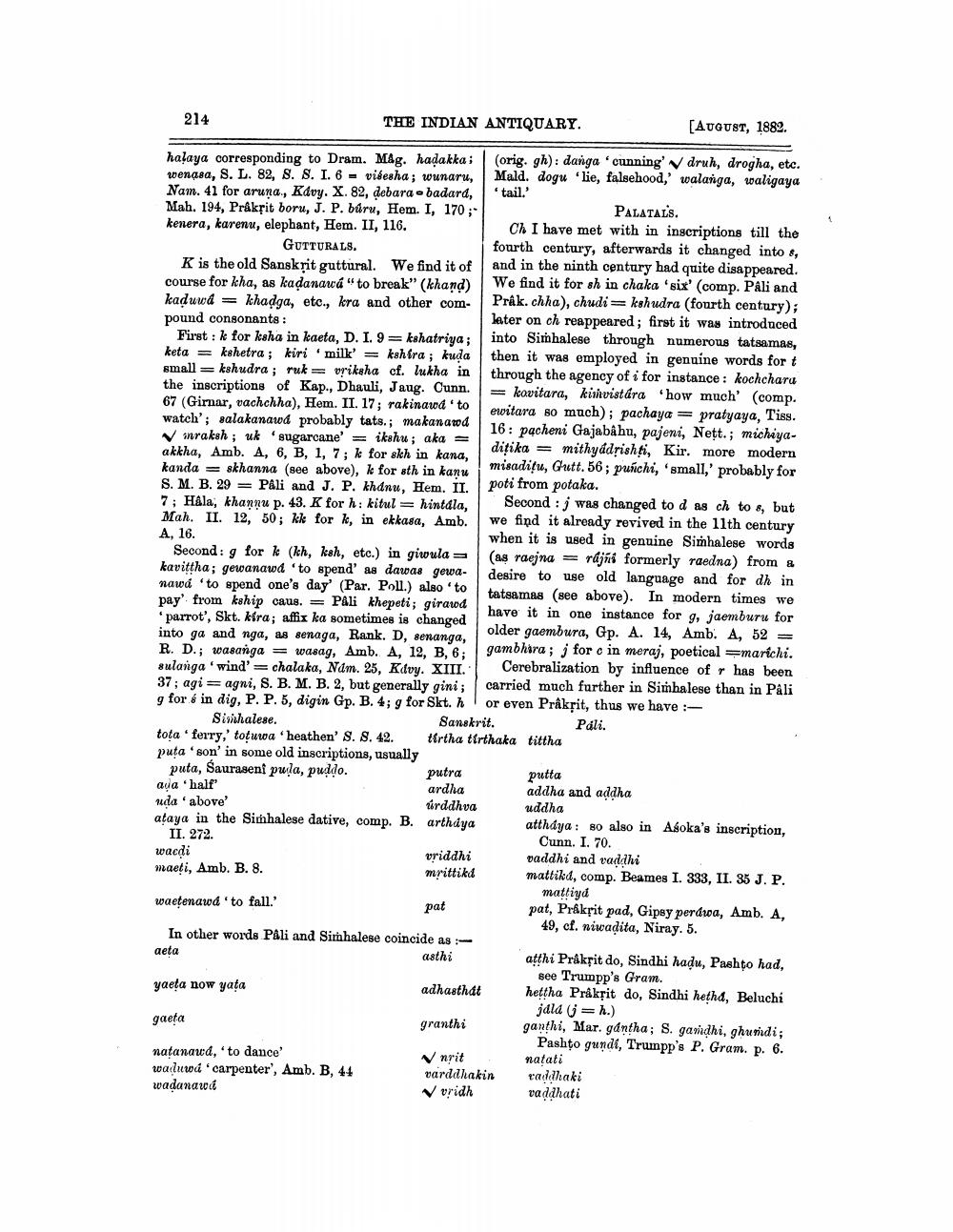________________
214
THE INDIAN ANTIQUARY.
halaya corresponding to Dram. Mag. haḍakka; wenasa, S. L. 82, S. S. I. 6 visesha; wunaru, Nam. 41 for aruna, Kdvy. X. 82, debara-badard, Mah. 194, Prâkrit boru, J. P. búru, Hem. I, 170;kenera, karenu, elephant, Hem. II, 116. GUTTURALS.
K is the old Sanskrit guttural. We find it of course for kha, as kaḍanawa" to break" (khand) kaduwa khadga, etc., kra and other compound consonants:
First: k for keha in kaeta, D. I. 9 kshatriya; keta kshetra; kiri milk' = kshira; kuda small kshudra; ruk vriksha cf. lukha in the inscriptions of Kap., Dhauli, Jaug. Cunn. 67 (Girnar, vachchha), Hem. II. 17; rakinawa 'to watch'; salakanawd probably tats.; makanawa nraksh; uk sugarcane' ikshu; aka akkha, Amb. A, 6, B, 1, 7; k for skh in kana, kanda = skhanna (see above), k for sth in kanu S. M. B. 29 Pâli and J. P. khánu, Hem. II. 7; Hâla, khannu p. 43. K for h: kitul hintala, Mah. II. 12, 50; kk for k, in ekkasa, Amb. A, 16.
=
Second: for k (kh, ksh, etc.) in giwula = kavittha; gewanawd 'to spend' as dawas gewanawa 'to spend one's day' (Par. Poll.) also 'to pay' from kship caus. = Pali khepeti; girawd 'parrot', Skt. kira; affix ka sometimes is changed into ga and nga, as senaga, Rank. D, senanga, R. D.; wasanga wasag, Amb. A, 12, B, 6; sulanga 'wind': chalaka, Nám. 25, Kávy. XIII. 37; agi agni, S. B. M. B. 2, but generally gini; g for é in dig, P. P. 5, digin Gp. B. 4; g for Skt. h Simhalese.
tota ferry,' totuwa 'heathen' S. S. 42.
puta 'son' in some old inscriptions, usually puta, Sauraseni pula, puddo.
PALATALS.
Ch I have met with in inscriptions till the fourth century, afterwards it changed into s, and in the ninth century had quite disappeared. We find it for sh in chaka 'six' (comp. Pâli and Prak. chha), chudi kshudra (fourth century); later on ch reappeared; first it was introduced into Simhalese through numerous tatsamas, then it was employed in genuine words for t through the agency of i for instance: kochchara kovitara, kimvistára 'how much' (comp. ewitara so much); pachaya: pratyaya, Tiss. 16: pacheni Gajabâhu, pajeni, Nett.; michiyadițika mithyadrishti, Kir. more modern misaditu, Gutt. 56; punchi, 'small,' probably for poti from potaka.
Second: j was changed to d as ch to 8, but we find it already revived in the 11th century when it is used in genuine Simhalese words (as raejna = rajn formerly raedna) from a desire to use old language and for dh in tatsamas (see above). In modern times we have it in one instance for g, jaemburu for older gaembura, Gp. A. 14, Amb. A, 52 = gambhira; j for c in meraj, poetical marichi.
Cerebralization by influence of r has been carried much further in Simhalese than in Pâli or even Prâkrit, thus we have :Sanskrit. tirtha tirthaka tittha
Páli.
yaeta now yata
gaeta
natanawd, to dance'
waduwa 'carpenter', Amb. B, 44 waḍanawa
putra
ardha
aya 'half'
uda' above'
úrddhva
ataya in the Simhalese dative, comp. B. arthaya II. 272.
wacḍi
maeți, Amb. B. 8.
waetenawd to fall."
pat
In other words Pâli and Simhalese coincide as :aeta asthi
[AUGUST, 1882.
(orig. gh): danga 'cunning' druh, drogha, etc. Mald. dogu lie, falsehood,' walanga, waligaya
'tail.'
vriddhi mrittika
adhasthat
granthi
Nnrit varddhakin
✔ vridh
putta addha and addha
uddha
atthaya: so also in Aśoka's inscription, Cunn. I. 70.
vaddhi and vaddhi
mattikd, comp. Beames I. 333, II. 35 J. P. mattiyd
pat, Prakrit pad, Gipsy perdwa, Amb. A, 49, cf. niwaḍita, Niray. 5.
atthi Prakrit do, Sindhi hadu, Pashto had, see Trumpp's Gram.
hettha Prakrit do, Sindhi hethd, Beluchi jala (j=h.)
ganthi, Mar. gántha; S. gandhi, ghumdi; Pashto gundi, Trumpp's P. Gram. p. 6. natati raddhaki vaddhati




